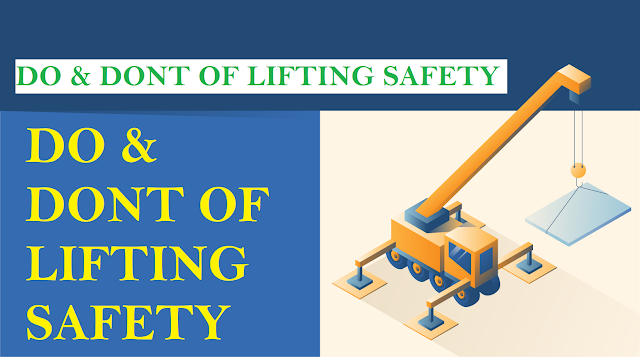DO & DONT OF LIFTING SAFETY
Dos and don’ts of equipment safety
Do…
Before using check the equipment is
well maintained and fit to be used, ie appropriate for the job, working
properly and all the safety measures are in place;
Ensure all parts, including
attachments, can accommodate the load weight;
Use the equipment properly and in
accordance with the OEM original equipment manufacturer’s instructions;
Ensure employees are wearing all the
appropriate protective clothing and equipment, required for that machine, such
as safety glasses, head protection and safety shoes.
Ensure the equipments are having
valid competent inspection & certification from the authority.
Ensure the safe working conditions.
Don’t…
Use equipment that has a danger sign or tag attached to it. Danger signs should only be removed by an authorized person who is satisfied that the equipment or process is now safe;
Remove any safeguards, even if
their presence seems to make the job more difficult;
Wear dangling chains, loose
clothing, rings or have loose long hair that could get caught up in moving
parts;
Distract people who are using
equipment.
Dos and don’ts of lifting safety
Do:
Use only certified lifting
equipment, marked with its safe working load, which is not overdue for
examination;
Ensure periodic inspections by the
competent authority.
Keep the reports of thorough
examination as well as any declarations of conformity or test certificates;
Make sure the load is properly
attached to the lifting equipment. If necessary, securely bind the load to
prevent it slipping or falling off;
Before lifting an unbalanced
load, find out its centre of gravity. Raise it a few inches off the ground and
pause – there will be little harm if it drops;
Use packaging to prevent sharp
edges of the load from damaging slings and do not allow tackle to be damaged by
being dropped, dragged from under loads or subjected to sudden loads;
FREE FREE - Training Module on WELDING
When using jib cranes, make sure
any indicators for safe loads are working properly and set correctly for the
job and the way the machine is configured;
Use outriggers where necessary;
When using multi-slings make sure
the sling angle is taken into account;
Have a responsible slinger or
banksman and use a recognized signaling system.
Stay away from the lifting swinging
area.
Barricade the lifting area.
Don’t…
Use unsuitable equipment, eg makeshift,
damaged, badly worn chains shortened with knots, kinked or twisted wire ropes,
frayed or rotted fiber ropes;
Exceed the safe working load of
machinery or accessories like chains, slings and grabs. Remember that the load
in the legs of a sling increases as the angle between the legs increases;
Lift a load if you doubt its
weight or the adequacy of the equipment.
Come under the suspended load.
LIST OF NFPA CODES & STANDARDS – PART 2





No comments:
Post a Comment